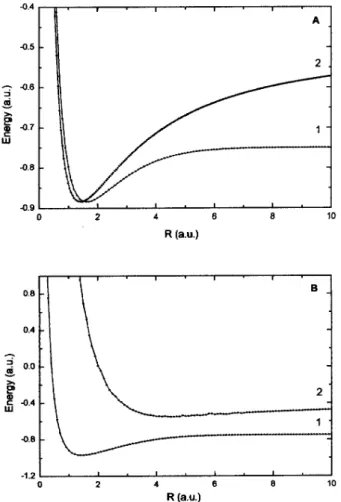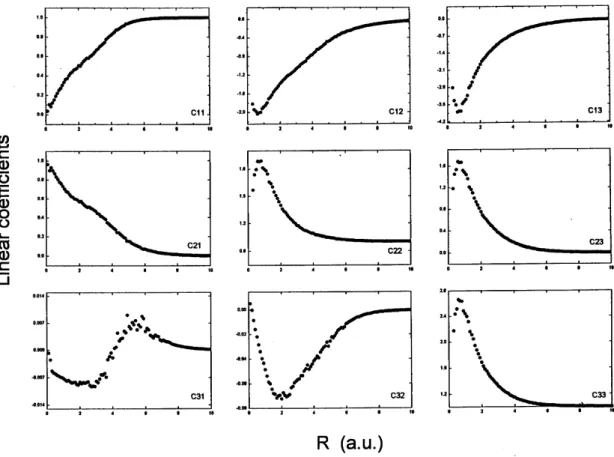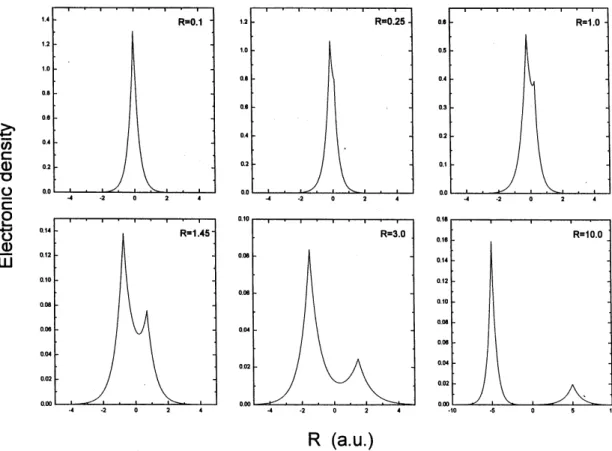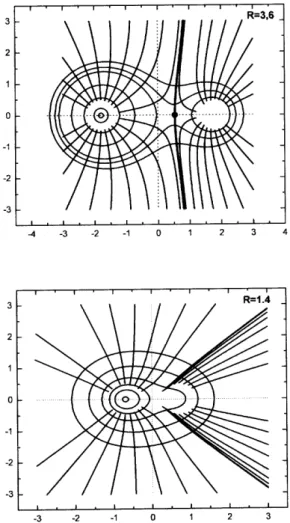Heteroisotopic molecular behavior.
The Valence-Bond Theory of the Positronium Hydride
Fl´avia Rolim, Tathiana Moreira, and Jos´e R. Mohallem
Laborat´orio de ´Atomos e Mol´eculas Especiais, Departamento F´ısica, ICEx,Universidade Federal de Minas Gerais, PO Box 702, 30123-970, Belo Horizonte, MG, Brazil
Received on 10 December, 2003
We develop an adiabatic valence-bond theory of the positronium hydride, HPs, as a heteroisotopic diatomic molecule. Typical heteronuclear ionic behaviour comes out at bonding distances, yielded just by finite nuclear mass effects, but some interesting new features appears for short distances as well.
1
Introduction
In theory of diatomic molecules, the concepts of homo and hetero nuclearity have been developed in a natural way, to recognize whether a molecule is made up of equal or dif-ferent atoms, respectively. Since atoms differ from each other by their atomic charge Z, which is contained in the potential energy part of the Hamiltonian operator, the Born-Oppenheimer (BO) theory of molecules [1], based on a clamped-nuclei electronic Hamiltonian, is sufficient to ac-count for these features and to explore all the consequences of point group symmetries displayed by the electronic wave-functions. Any further features yielded by coupling of electronic and nuclear motion are treated as non-adiabatic effects, whose calculations involve many BO states [1]. For polyatomic molecules, the concept and terminology of ”equivalent atoms ” are introduced, meaning units of the same chemical element that transform among each other by symmetry operations (for example, the two hydrogen atoms in the water molecule).
On the other hand, recent developments have shown that a variational adiabatic (non-BO) approach for the electronic problem is able to account for another property of atoms, their massM(the isotopic effect), in a somewhat analogous way of Z [2]-[6]. This introduces the idea of homo and heteroisotopic molecular behavior. For example, being D the symbol for deuterium, H2O and D2O are homoisotopic
but HDO is heteroisotopic, the last one having its symmetry broken fromC2vtoCs[6]. The consequent isotope shifts,
dipole moments and new spectroscopical transitions, are real and measurable [7].
This new way of symmetry classification of molecules may look strange, however, as it is generated by kineti-cal terms of the total Hamiltonian, instead of by a rigid framework of nuclear charges. Furthermore, for typical molecules, the effects are too small to be visualized in elec-tronic density maps, as usually done in the common homo and heteronuclear cases. The theoretical signature of metry breaking is just the non-commutability of some sym-metry operators with the adiabatic Fock operator [6].
Fortunately, there is the singular case of the positronium
hydride, HPs (H=H+e−
+ Ps=e+e−
), which can be seen as an extreme homonuclear but heteroisotopic isotopomer of H2. The large difference between the proton and positron
masses yields a considerable asymmetry, that stimulates us to investigate how it affects the electronic distribution, in comparison with the common heteronuclear case (which we call here theZ −M analogy). As a matter of fact, Saito [8] has already pointed out that the electronic den-sity of HPs, obtained from four-body correlated calcula-tions, shows a visual approximate molecular behavior, but this kind of approach can give no further structural details, however. We are, on the other hand, interested in explor-ing possibleZ−M analogy effects with a theory in which the ”nuclear ” (proton and positron) and electronic motions are adiabaticaly separated, that is, with the same theoretical treatment used with standard isotopomers, in order to better understand their isotopic properties.
It is well known that the valence-bond (VB) theory is appropriate to analyse in detail the bonding of a typical di-atomic molecule. Particularly for a heteronuclear one, a mixed covalent-ionic behavior of the wavefunction points to a polarization of the electronic distribution toward the more electronegative atom, measured by the relative value of the linear coefficient of the ionic structure. Furthermore, the ex-ponents of the atomic orbitals measure the effective charge of each nucleus felt by the electrons and become indicative of the same above effect, as well. Classical chemical con-cepts as, for example, electronegativity, have immediate in-terpretation in terms of the VB output.
Here, we check whether a VB calculation of HPs is able to study the consequences of its mass asymmetry on the electron distribution and deeply explore theZ −M anal-ogy. This is done in the following section.
2
The valence-bond theory of HPs
2.1
Methodology
has been to look for electronic wavefunctionsΦk that are
eigenfunctions of the total Hamiltonian, instead of the BO one, that is,
HΦk =ǫkΦk. (1)
Different from the common adiabatic approximation [9], that corrects just the electronic energy (or the potential en-ergy curves, PEC), this approach allows the electronic wave-functions to account for the nuclear motion as well. A product wavefunction is assumed for any state k, that is, Ψk = Φkχk, whereχis a nuclear wavefunction. The
so-lution of equation (1) is done in a variational sense, which explains the terminology ”variational adiabatic ”. Further approximations are explained bellow.
The system, ABe−
e−
, is treated as being heteroiso-topic, which means here that the positive nucleiA(H+
) and
B(e+
), separated by the distanceR, have different masses,
MAandMB (MB = 1ua), but the same charge,Z = +1
au.
For the definition of our electronic basis, we consider a covalent (Heitler-London, HL), and two ionic VB struc-tures, so that a spatial symmetric state can be written as the superposition
Φk =ck1[a(1)b(2) +a(2)b(1)]
+ck2a(1)a(2) +ck3b(2)b(2). (2)
Here,aandbare normalized1sorbitals centered on nu-cleiAandB, with exponentsζAandζB, respectively, being
all the linear and non-linear parameters dependent onR. To save notation, we refer, in what follows, to the HL,A-ionic andB-ionic structures, with obvious meaning, and call this set the VB basis.
We first attempt to solve equation (1) to obtain the PECs
Uk(R) =ǫk(R) +
1
R.
On this level, the problem has been treated, in our lab-oratory, within a modified-electron-mass approach [2],[3], which works well for one and two-electron homonuclear di-atomic molecules. For more complicated systems we re-sorted to an empirical correction [4] for which a model Hamiltonian has been developed later [10]. Summarizing the prescription of ref. [4], first assume that for an electron occupying the atomic orbitalacentered on a nucleusAwith massMA, the finite nuclear mass correction (FNMC) to its
energy is (unormalized),
QA=
a(1) −∇21
a(1)
2MA
. (3)
This correction is exact for an isolated non-relativistic hydrogenic atom. For a polyatomic molecule, the FNMC is accomplished by considering the BO hamiltonian in the standard formHBO = ih(i) +
1
rij, where theh(i)are
one-electron hamiltonians, and obtaining its matrix elements in the electronic basis. Wherever a term likea|h|a ap-pears in any of these matrix elements, a correction like (3) is added to it, provided that terms originated by symmetriza-tion of a VB structure contribute just once. This procedure
assures that the corrections will be properly placed in the hamiltonian matrix. In the present case, the ground state (gs) correction with wavefunction (2), becomes simply
Q=c21(QA+QB) +c22(2QA) +c23(2QB)
+c1c2QA a|b+c1c3QB b|a. (4)
Note that if the one-electron atoms are set apart, only the first term survives and the correction becomes exact. For fi-niteR, the correction performs quite well, as shown in refs. [3],[4]. The same result of equation (4) could be obtained with the model Hamiltonian for the FNMC [10] as well.
The atomic orbitals and the linear coefficients are opti-mized in order to minimize the adiabatic electronic energy,
ǫk(R) =ǫBOk(R) +Qk(R), (5)
which yields the PECs for each statek. The results of tions (4) and (5) express our approximate solution of equa-tion (1).
2.2
The VB basis
Before concerning the complete expansion of the wavefunc-tion in the VB basis, it is interesting to verify how this non-orthogonal basis can be devised. Our treatment resembles an old one by Zener [11] for ionic molecules, but with some additional complications due to the need of variational de-termination of each state (see bellow). We ignore for while theB-ionic structure, since, in view of the smaller energy of the corresponding dissociation products, H+
+ Ps−
, it must not correspond to a low-lying state of the system. On the contrary, the HL structure and theA-ionic structure are ex-pected to correlate to lower states of HPs.
With just the HL structure as the electronic wavefunc-tion, the FNMC (4) becomesQ = QA+QB, and a
vari-ational calculation of the PEC yields curve1of Fig. 1A. It advances the dissociation of the system in H + Ps, giving the exact separated-atom (SA) energy,E(∞) =−0.74973 au. With theA-ionic structure, the correction isQ= 2QA
and curve2is obtained, which advances the dissociation in H−
+Ps+
, with the independent particle approximation en-ergy of E(∞) = −0.53858au. Curve 1 must thus cor-relate better to the electronic ground state. As a matter of fact, both curves, corresponding to non-orthogonal states, mimic the ground state, for intermediate values ofR. In the united-atom (UA) limit, the HL structure tend to imitate the ionic one, which is far more appropriate to this limit, so that the curves close approach and cross (not an actual crossing, however).
This study justifies our chosen VB basis. It advances two equally important structures, the HL being the one that must dominate the wavefunction at large distances, the A-ionic being dominant at small distances and the mixing of them accounting for most of the bonding features. TheB-ionic structure, centered one+
Figure 1.A- Potential energy curves for the1) covalent and2)A -ionic electronic states of HPs,B- Potential energy curves for the1) ground bonding and2) first excited state of HPs.
In some extent, this behavior of the VB basis is analo-gous to that reported for typical ionic molecules [11],[12], in which no effects of nuclear motion are considered, however. In spite the two atoms having the same nuclear charge and just one electron each, the mass effects advances theA-ionic structure as fundamental in the description of the electronic gs of HPs.
2.3
Calculations with the full VB basis
We next diagonalize the hamiltonian in the full VB basis, obtaining three electronic statesΦk, each one generating a
PEC. They are obtained with simultaneous optimization of the parametersck1,ck2,ck3,ζAandζBfor each value ofR,
to get the minimum of the gs PEC at eachR. An immediate effect is the uncrossing of the first two lower curves, shown in Fig. 1B. The lower curve becomes the bonding1
gstate
of HPs, and the second correlates with higher states having H−
as a dissociation product (there are other states of in-termediate energy between them, corresponding to orbital excitations of the H and Ps atoms in the SA limit).
We then solve the nuclear equation,
[− ∇
2
R
2µAB
+Uk(R)−E]χk(R) = 0,
for the bound state nuclear wavefunctionχ1(R)and the
cor-responding energyE1. Although the minimum of the PEC
is around1.3 au, we cannot speak here of an equilibrium position, due to positron delocalization. The nuclear wave-function displays this feature, spreading on a larger range of distances in comparison with H2, and lead to an average
proton-positron distance ofR = 3.34au. In view of this behavior, we consider the bonding distance as lying in the range3≤R≤4au.
The energy for the S bound state of HPs is E =
−0.7889 au [13]. We obtained E1 = −0.7668 au with
the reduced mass of the nuclei (µAB), andE1 = −0.8070
au with the empirical reduced mass of the atoms (µatAB = ( 1
MA+1+ 1
MB+1)
−1
). Some researchers have pointed a con-nection between non-adiabatic effects and a reduced mass variable withR[14],[15],[9],[16]. When we use an empiri-cal average reduced mass defined as
µaveAB =c
2
1µHLAB+c
2
2µionAAB +c
2 3µionBAB
c2 1+c
2 2+c
2 3
,
with µHL
AB = µatAB, µionAAB = (
1
MA+2 + 1
MB)
−1
, etc., we get a very reasonable energy of −0.7879 au. For the pair annihilation rate, calculated with the for-mula Γ = −50.47Ψ|δ(−→re+− −→re−|Ψ [17], we get
2.42 x 109
s−1
, which compares well with the accepted value of2.32x109
s−1
[18]. However, the point here is not to get accurate calculations of properties, which could not be attained with our n¨aive wavefunction anyway. These results serve only to lend reliability to theZ−M analogies we are looking for.
The expansion coefficients, shown in Fig. 2, confirm the mixed covalent-ionic behavior of the ground and excited electronic states. Particularly for the gs (coefficientsck1),
we note the expected predominance of theA-ionic structure at small distances and of the covalent one at large distances, both of them being important at bonding distances, with close analogy with the typical ionic molecule case. On the other hand, the coefficient of theB-ionic structure is very small for any value ofR. This feature is not a surprise since we do not expect the clustere−
e+
e−
(stable, with energy of
−.262au) to be relevant in the bonding of HPs.
Another interesting outcome is the behavior of the or-bital exponents, or effective charges, for the ground state, Fig. 3. They are measures of the size of the atomic orbitals and of screening effects. The exponentζBof the isolated Ps
atom is already half of thee+
charge, due to reduced mass effects. The orbitala, with exponentζA, presents an
anal-ogous variation withR as for H2[19]. From large values
untilR 2 ua,ζB shows a regular behavior as well. We
can identify the effective charges around0.9au for the pro-ton and0.6 au for the positron (at large distances they are exactly1.and0.5respectively, the last one already includ-ing reduced mass effects). In spite the real charges beinclud-ing both+1.0, the mass effects impose a behavior of the ef-fective charges, mainlyζB, analogous to what happens in a
Figure 2. Linear coefficients, in relative units, versus nuclear distance. Note that the vertical scales are not necessarily the same.
For smaller values ofR, on the other hand, the behav-ior ofζB becomes singular. Close toR = 3.0au it starts
growing up critically, before falling down to the expected UA limit. The explanation is that the corresponding strong contraction of the orbital b centered on e+
, illustrated in the inset of Fig. 4, is necessary in order to the positron to cross the electronic cloud of the H atom and the electrons to change their motion, and adapt to the orbital of the com-posite nucleus H+
+ e+
. In this process, the system must change its dimensional scale, from the scale of an exotic diffuse positronic molecule to that of a typical atom. This behavior seems to have no analog in any other typical ionic molecules, and is a major difference encountered between HPs and typical systems (in fact, a test on HeH+ did not show such effect). This is a singular consequence of the asymmetric behavior of the electronic distribution of HPs being caused by nuclear mass differences, instead of charge differences.
Most illustrative results are the graphs of the electronic densities on the molecular axis, shown in Fig. 4, and the cor-responding contour maps in a plane that contains the axis, in Fig. 5, for some values ofR. They give an idea of the dy-namical formation of the system from the constitutive atoms. The electronic densities show a typical chemical bonding profile, with well defined peaks on the nuclei and a valley between them. The contour maps are shown for different situations, from the SA to the UA limits. The R = 3.0 map is typical of the HPs bonding distance. TheR = .25 map corresponds to the more extreme contraction of orbital
b. ForR= 0.1it seems that the system had almost become the UA atom, with spherical symmetry. With due care to the different scales of the figures, the reader can note the di-mensional change from the exotic molecule to the UA typ-ical atom (realize also that the real dimension is inversely proportional to the dimension of the pictures). For distances aroundR= 1.0au, the contour maps are analogous of those of diatomic molecules with disparate nuclear charges [20]. These kind of molecules present a strong ionic behavior re-flected in a large contribution of the ionic structure in the VB wavefunction. In this region, the Ps atom seems to loose its identity in the complex, which suggested the next appli-cation.
2.4
The topology of the electronic density
A modern analysis of molecular structure is the topological study of the electronic density, developed mainly by Bader and collaborators [20]. The gradient field of the electronic densityρis characterized by regions (basins) separated by surfaces of−→∇ρ = 0. These basins are identified as “topo-logical atoms”. We use this technique to investigate whether the positronium atom keeps its identity in the HPs complex, for different values ofR. The gradient of the gs electronic density−→∇ρ=−→∇Φ∗
1Φ1, with electronic wavefunction (2), is
easily obtained in elliptical coordinates, yielding the graphs in Fig. 6. Once again, typical heteronuclear behavior comes out at bonding distances, with the topological Ps atom occu-pying a smaller basin than the topological H atom, shown in theR = 3.6au graph. In this kind of analysis, a signature of chemical bonding is the appearance of a critical point be-tween atomsAandB, which is present in our system from
R= 3.0au to much larger values. ForRsmaller than this value, corresponding to the region where the Ps orbital start contracting, the critical point disappear, which constitutes a further indication that for these distances the system has a singular behavior, and seems to mean that the topological Ps does not exist anymore. This is expressed in theR = 1.45 au graph, where no critical point appears and no clear divi-sion of the basins can be devised between the nuclei.
3
Further discussion
The variational adiabatic approximation to the molecular problem introduces the finite nuclear masses into the elec-tronic Hamiltonian. The mass asymmetry is able to gen-erate symmetry breaking phenomena analogous to charge asymmetry. This considerations lead us to the concepts of homo and heteroisotopic molecules (accordingly, we might be tempted to propose the replacement of the usual terms “homo and heteronuclear” by “homo and heteroatomic”, but the terminology is already firmly established).
The results obtained here with VB theory, that show HPs somewhat as an ionic molecule in the bonding region, impose a modification in the way we face the very con-cept of molecular structure. In a sense, it seems that we should decouple the symmetry properties of the electronic distribution from the idea of a rigid nuclear geometry, since these properties look the same, no matter they are estab-lished by charge or mass effects. On the contrary, these ef-fects seem to be interchangeable. In atomic physics we find an analogous feature. The Hamiltonian of an one-electron atomH = −∇2
2µ − Z
r can be changed to the scaled form
Hesc = µH =−∇
2
2 −
ζ
r, withζ = µZ, that is, a
mass-scaled Hamiltonian describes an atom of fixed center and different charge,ζ.
In view of these considerations, it becomes much eas-ier to interpret some properties of isotopomers, as for ex-ample, the dipole moment of HD. From the BO theory, it has its source in complicated non-adiabatic couplings of electronic, vibrational and rotational states [21]. From the present point of view, the dipole moment is a consequence of the asymmetric electronic distribution, generated by finite nuclear mass effects. Other properties will be more easily interpreted on this basis as well.
Acknowledgements
Figure 4. Electronic densities on the molecular axis for some values of the nuclear distance.
Figure 6. Field lines of the gradient of the electronic density for two inter-nuclear distances. The point in black in theR = 3.6au curve is the critical point.
References
[1] M. Born and K. Huang, Dynamical theory of crystal lattices (Oxford University Press, New York, 1956).
[2] J. R. Mohallem, J. Phys. B: At Mol. Opt. Phys. 32, 3805 (1999).
[3] J. R. Mohallem, F. Rolim and C. P. Gonc¸alves, Mol. Phys.99, 87 (2001).
[4] C. P. Gonc¸alves and J. R. Mohallem, Theor. Chem. Acc.110, 367 (2003).
[5] C. P. Gonc¸alves and J. R. Mohallem, Chem. Phys. Lett.367, 533 (2003).
[6] C. P. Gonc¸alves and J. R. Mohallem, Chem. Phys. Lett.380, 378 (2003).
[7] A. de Lange, E. Reinhold and W. Ubachs, Int. Rev. Phys. Chem.21, 257 (2002).
[8] S. L. Saito, Nucl Instr and Meth in Phys Res B 171, 60 (2000).
[9] See, for example, N. C. Handy and A. M. Lee, Chem. Phys. Lett.252, 425 (1996).
[10] J. R. Mohallem, J. Mol. Struct. Theochem, in press.
[11] C. Zener, Proc. Roy. Soc. Ser. A137, 696 (1932).
[12] R. S. Berry, J. Chem. Phys.27, 1288 (1957).
[13] A. M. Frolov and V. H. Smith, Jr, Phys. Rev. A55, 2662 (1997).
[14] W. Meyer, P. Botschwina, and P. Burton, J. Chem. Phys.84, 891 (1986).
[15] R. R¨ohse, W. Kutzelnigg, R. Jaquet, and W. Klopper, J. Chem. Phys.101, 2231 (1994).
[16] F. Rolim, J. P. Braga, and J. R. Mohallem, Chem. Phys. Lett. 332, 139 (2000).
[17] Chang Lee, Zh. Eksp. Teor. Fiz.33, 365 (1958) [Sov Phys JETP6, 281 (1958)].
[18] J. Mitroy, M.W. Bromley, and G.G. Ryzhikh, J. Phys. B: At Mol. Opt. Phys.35, R1 (2002).
[19] J. O. Hirschfelder and J. W. Linnet, J. Chem. Phys.18, 130 (1949).
[20] R. F. W. Bader,Atoms and Molecules, a Quantum Theory, Claredon Press, Oxford, 1995.



